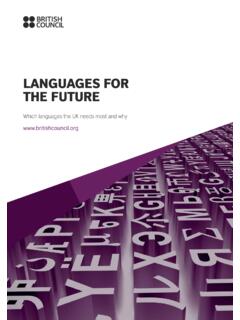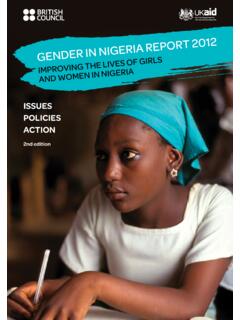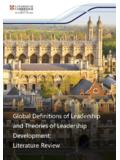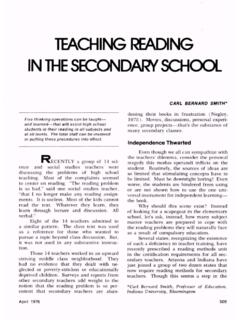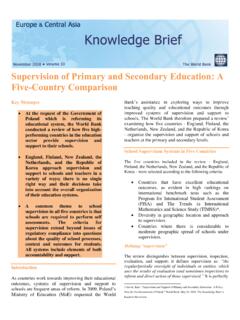Transcription of LANGUAGE TRENDS 2016/17 LANGUAGE TEACHING IN …
1 LANGUAGE TRENDS 2016/17 LANGUAGE TEACHING IN primary AND secondary SCHOOLS IN ENGLANDSURVEY REPORTby Teresa Tinsley and Kathryn CONTENTS LANGUAGE TRENDS 2016/17 02 123456 78910 EXECUTIVE SUMMARY Page 03 CHAPTER 1 INTRODUCTION THE LONG-STANDING CHALLENGES NEW CHALLENGES AND OPPORTUNITIES ISSUES FOR THIS YEAR S SURVEY Page 09 CHAPTER 2 METHODOLOGY RESEARCH DESIGN AND DATA COLLECTION ANALYSIS OF EXAMINATION DATA DEVELOPMENT OF THE QUESTIONNAIRES DATA COLLECTION RESPONSE RATES ANALYSIS OF THE FINDINGS Page 12 CHAPTER 3 EX AMINATION STATISTICS GCSE ENTRIES IN LANGUAGE SUBJECTS A-LEVEL ENTRIES IN LANGUAGE SUBJECTS KEY POINTS Page 16 CHAPTER 4 LANGUAGE TEACHING IN primary SCHOOLS PROVISION FOR LANGUAGES primary SCHOOLS AND THE NEW NATIONAL CURRICULUM TEACHERS.
2 THEIR TRAINING AND QUALIFICATIONS WIDER ISSUES FOR primary LANGUAGES KEY POINTS Page 24 CHAPTER 5 FROM KEY STAGE 2 TO KEY STAGE 3 Page 42 CHAPTER 6 PROVISION FOR LANGUAGES IN secondary SCHOOLS LANGUAGES TAUGHT TIME ALLOCATED CHANGES TO PROVISION Page 55 CHAPTER 7 TAKE UP FOR LANGUAGES IN secondary SCHOOLS KEY STAGE 3 KEY STAGE 4 POS T 16 KEY POINTS Page 68 CHAPTER 8 LANGUAGE TEACHER SUPPLY AND TRAINING IN secondary SCHOOLS CPD TEACHER SUPPLY AND RETENTION LANGUAGE ASSISTANTS KEY POINTS Page 85 CHAPTER 9 ISSUES OF CONCERN FOR TEACHERS OF LANGUAGES IN secondary SCHOOLS Page 92 CHAPTER 10 CONCLUSIONS Page 98 APPENDICES Page 103 EXECUTIVE SUMMARY LANGUAGE TRENDS 2016/17 03 123456 78910 EXECUTIVE SUMMARYL earning another LANGUAGE not only provides practical communication skills, but has a unique role to play in developing cognition, literacy and cultural knowledge.
3 The annual LANGUAGE TRENDS surveys gather information on how well primary and secondary schools are providing for this important, but sometimes challenging, area of the school curriculum, and the challenges they face. Our research, which has been conducted annually since 2002, provides a unique, longitudinal record of LANGUAGE TEACHING in both independent and state secondary schools across England. Over the years, we have been able to track the implementation and impact on teachers and their pupils of far-reaching educational policies, such as the decision to make the study of a LANGUAGE optional at Key Stage 4 in 2004, and to provide a useful conduit for teachers views on a wide range of issues affecting their professional lives.
4 Since 2012, when it was announced that the study of a LANGUAGE would become compulsory for all pupils in Key Stage 2, the LANGUAGE TRENDS research has also included an annual survey of English primary schools. Previous years LANGUAGE TRENDS reports can be found at: 2016/17 survey was carried out between September and December 2016, with an invitation to complete the survey sent to 2,970 state secondary schools, 655 independent secondary schools and 3,000 state primary schools. Following an initial low response rate from primary schools, the sample was doubled to 6,000.
5 Responses were received from 701 state secondary schools, 146 independent schools and 727 primary year s LANGUAGE TRENDS research was launched at the point at which the UK is embarking on a process to readjust its relationships with the rest of the world as a result of the vote to withdraw from the European Union (EU). It is not yet known how radical this readjustment will be and how it will affect our relationships with the countries whose languages are most commonly taught in English schools, namely French, German and Spanish.
6 However, a diminishing supply of young, home-grown linguists available to businesses wishing to work internationally or to train as teachers could create long-term difficulties for the country particularly post Brexit when access to the current supply of multilingual professionals from mainland Europe may also be restricted. This survey provides the first indications from teachers of the potential impact of the vote to leave the EU on LANGUAGE TEACHING in schools. In November 2016, the TEACHING Schools Council published a review of modern foreign languages TEACHING practice, highlighting the damage both to pupils and to the national interest of the low levels of participation and achievement seen in languages at GCSE.
7 The report noted that less than a third of pupils currently achieve a good GCSE in a LANGUAGE , judging the decline in numbers taking A-level to be of disastrous proportions .1 Failure to achieve a good grade in a LANGUAGE is the main obstacle to achieving the English Baccalaureate (EBacc), the performance measure for schools introduced in 2011, which the government hopes will be achieved by 90 per cent of pupils. An exploration of how schools are responding to this aspiration, and how LANGUAGE TEACHING in primary schools might, in due course, contribute to this ambitious aim, form the backbone of this year s report.
8 We look at the implications for languages in Key Stage 3 and Post-16, and also present data exploring inequalities in LANGUAGE learning based on regional and socio-economic factors, gender, and type of school . The survey also raises issues specifically reported by respondents as matters of concern. These include the issue of funding for schools and colleges (the Association of Colleges reported recently that languages are among the worst-hit subjects as a result of cuts being made to post-16 courses), concerns relating to the implementation of new EXECUTIVE SUMMARY LANGUAGE TRENDS 2016/17 04 123456 78910specifications for GCSE and A-level, and guidelines relating to child safety which are proving an obstacle to many schools longstanding international visits and exchange programmes.
9 EX AMINATION DATAAs in other years, our report is prefaced by an analysis of the examination data made available by the Department for Education (DfE). This reveals that participation in GCSE languages has stabilised at just under 50 per cent of the cohort, in spite of the initial gains seen in the first year after the introduction of the EBacc. There are wide variations in the numbers of pupils taking languages at GCSE by region and local authority, and a growing disparity between the 65 per cent of pupils who take a LANGUAGE to GCSE in Inner London, and the 43 per cent in the North East, falling to 28 per cent in number of pupils taking a LANGUAGE at A-level is down by one third since 1996, with a decrease of three per cent in the past year alone.
10 The last 20 years have seen a huge shift away A-level entrants for French and German, which in 1996 accounted for more than 80 per cent of candidates, towards Spanish and other languages, which now represent more than half of candidates. However, in the past year, Spanish and other languages have also been affected by declining numbers, making post-16 LANGUAGE study one of the most pressing concerns to be addressed. A-level entries for languages are heavily skewed toward female candidates (64 per cent) and towards the independent sector, which accounts for 32 per cent of LANGUAGE entries, from a share of the post-16 pupil cohort of only 18 per cent.




